SAAB 9-3 2000 User Guide
Manufacturer: SAAB, Model Year: 2000, Model line: 9-3, Model: SAAB 9-3 2000Pages: 236, PDF Size: 10.85 MB
Page 11 of 236
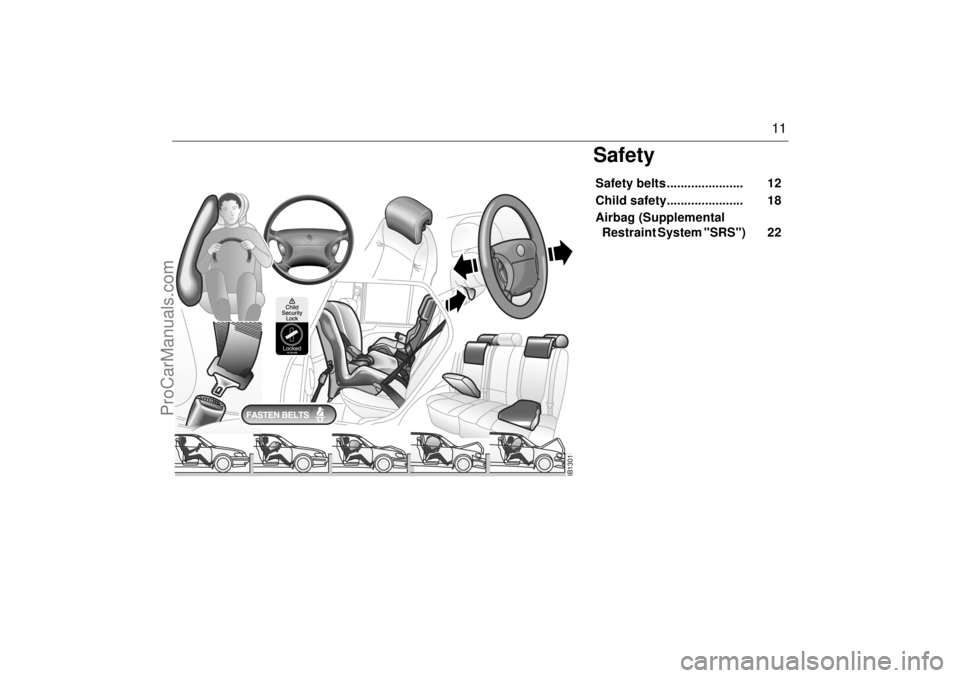
11
SafetySafety belts ...................... 12
Child safety...................... 18
Airbag (Supplemental
Restraint System "SRS") 22
IB1301
ProCarManuals.com
Page 12 of 236
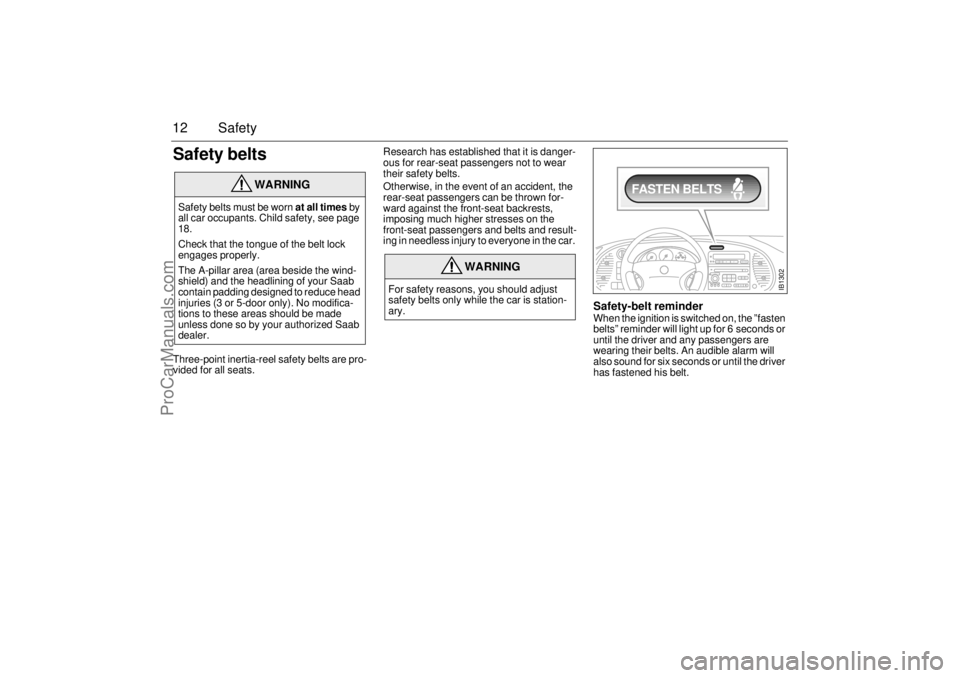
12 SafetySafety belts Three-point inertia-reel safety belts are pro-
vided for all seats. Research has established that it is danger-
ous for rear-seat passengers not to wear
their safety belts.
Otherwise, in the event of an accident, the
rear-seat passengers can be thrown for-
ward against the front-seat backrests,
imposing much higher stresses on the
front-seat passengers and belts and result-
ing in needless injury to everyone in the car.
Safety-belt reminder When the ignition is switched on, the ”fasten
belts” reminder will light up for 6 seconds or
until the driver and any passengers are
wearing their belts. An audible alarm will
also sound for six seconds or until the driver
has fastened his belt.
WARNING
Safety belts must be worn at all times by
all car occupants. Child safety, see page
18.
Check that the tongue of the belt lock
engages properly.
The A-pillar area (area beside the wind-
shield) and the headlining of your Saab
contain padding designed to reduce head
injuries (3 or 5-door only). No modifica-
tions to these areas should be made
unless done so by your authorized Saab
dealer.
WARNING
For safety reasons, you should adjust
safety belts only while the car is station-
ary.
FASTEN BELTS
IB1302
ProCarManuals.com
Page 13 of 236
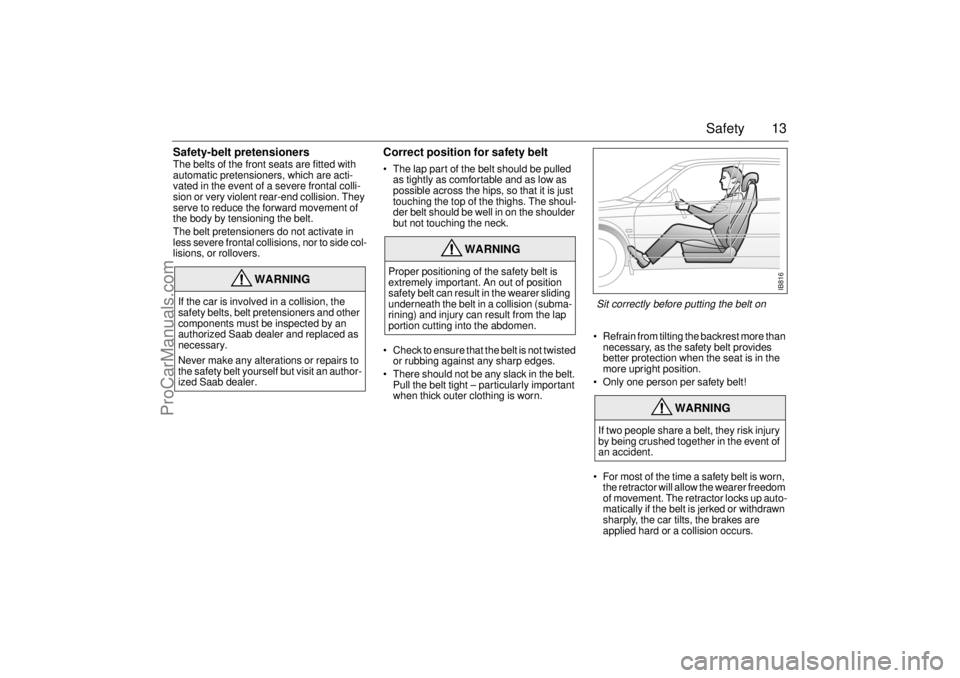
13 Safety
Safety-belt pretensionersThe belts of the front seats are fitted with
automatic pretensioners, which are acti-
vated in the event of a severe frontal colli-
sion or very violent rear-end collision. They
serve to reduce the forward movement of
the body by tensioning the belt.
The belt pretensioners do not activate in
less severe frontal collisions, nor to side col-
lisions, or rollovers.
Correct position for safety belt The lap part of the belt should be pulled
as tightly as comfortable and as low as
possible across the hips, so that it is just
touching the top of the thighs. The shoul-
der belt should be well in on the shoulder
but not touching the neck.
Check to ensure that the belt is not twisted
or rubbing against any sharp edges.
There should not be any slack in the belt.
Pull the belt tight – particularly important
when thick outer clothing is worn. Refrain from tilting the backrest more than
necessary, as the safety belt provides
better protection when the seat is in the
more upright position.
Only one person per safety belt!
For most of the time a safety belt is worn,
the retractor will allow the wearer freedom
of movement. The retractor locks up auto-
matically if the belt is jerked or withdrawn
sharply, the car tilts, the brakes are
applied hard or a collision occurs.
WARNING
If the car is involved in a collision, the
safety belts, belt pretensioners and other
components must be inspected by an
authorized Saab dealer and replaced as
necessary.
Never make any alterations or repairs to
the safety belt yourself but visit an author-
ized Saab dealer.
WARNING
Proper positioning of the safety belt is
extremely important. An out of position
safety belt can result in the wearer sliding
underneath the belt in a collision (subma-
rining) and injury can result from the lap
portion cutting into the abdomen.
WARNING
If two people share a belt, they risk injury
by being crushed together in the event of
an accident.
IB816
Sit correctly before putting the belt on
ProCarManuals.com
Page 14 of 236
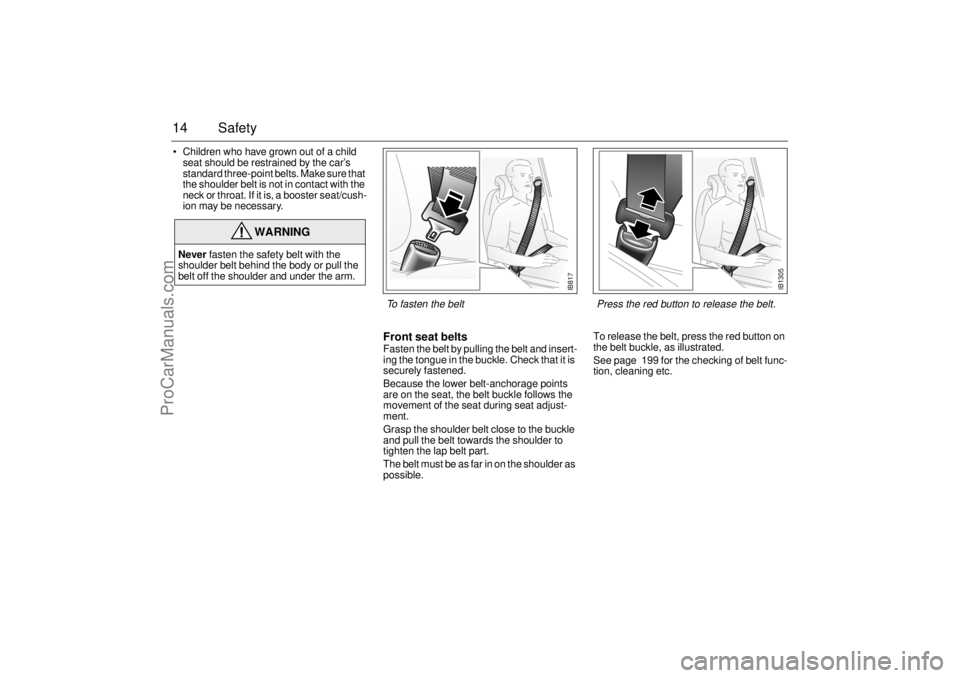
14 Safety Children who have grown out of a child
seat should be restrained by the car’s
standard three-point belts. Make sure that
the shoulder belt is not in contact with the
neck or throat. If it is, a booster seat/cush-
ion may be necessary.
Front seat belts Fasten the belt by pulling the belt and insert-
ing the tongue in the buckle. Check that it is
securely fastened.
Because the lower belt-anchorage points
are on the seat, the belt buckle follows the
movement of the seat during seat adjust-
ment.
Grasp the shoulder belt close to the buckle
and pull the belt towards the shoulder to
tighten the lap belt part.
The belt must be as far in on the shoulder as
possible.To release the belt, press the red button on
the belt buckle, as illustrated.
See page 199 for the checking of belt func-
tion, cleaning etc.
WARNING
Never fasten the safety belt with the
shoulder belt behind the body or pull the
belt off the shoulder and under the arm.
IB817
To fasten the belt
IB1305
Press the red button to release the belt.
ProCarManuals.com
Page 15 of 236
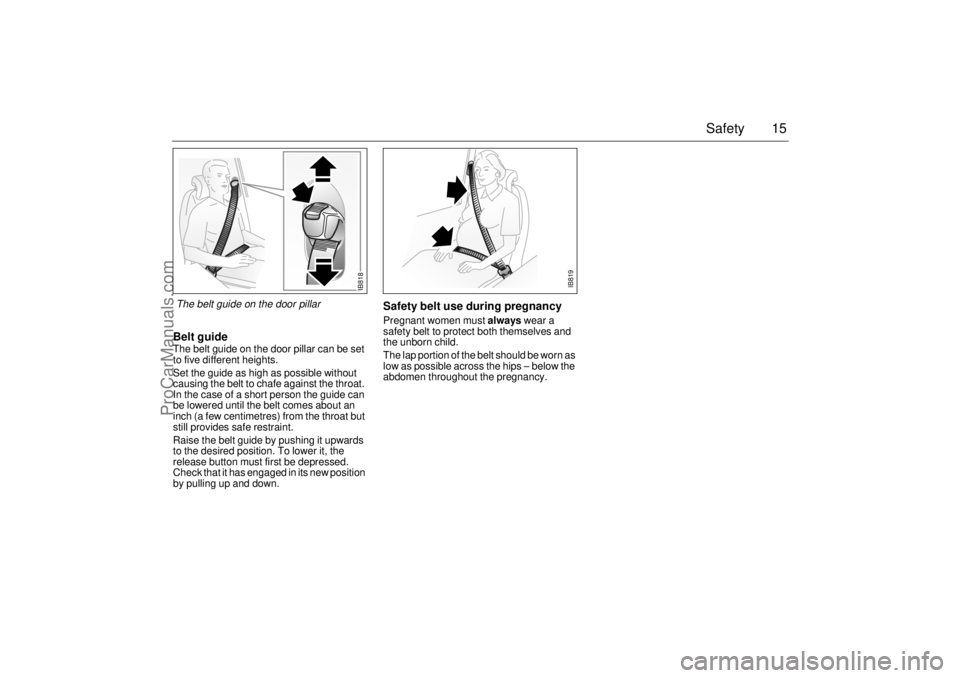
15 Safety
Belt guide The belt guide on the door pillar can be set
to five different heights.
Set the guide as high as possible without
causing the belt to chafe against the throat.
In the case of a short person the guide can
be lowered until the belt comes about an
inch (a few centimetres) from the throat but
still provides safe restraint.
Raise the belt guide by pushing it upwards
to the desired position. To lower it, the
release button must first be depressed.
Check that it has engaged in its new position
by pulling up and down.
Safety belt use during pregnancyPregnant women must always wear a
safety belt to protect both themselves and
the unborn child.
The lap portion of the belt should be worn as
low as possible across the hips – below the
abdomen throughout the pregnancy.
IB818
The belt guide on the door pillar
IB819
ProCarManuals.com
Page 16 of 236
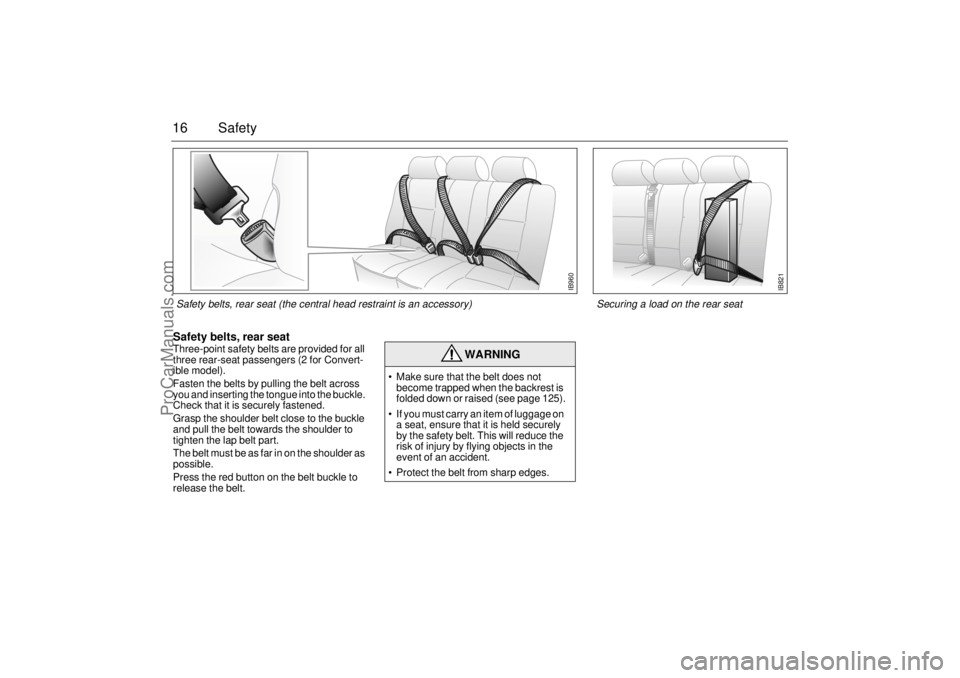
16 SafetySafety belts, rear seat Three-point safety belts are provided for all
three rear-seat passengers (2 for Convert-
ible model).
Fasten the belts by pulling the belt across
you and inserting the tongue into the buckle.
Check that it is securely fastened.
Grasp the shoulder belt close to the buckle
and pull the belt towards the shoulder to
tighten the lap belt part.
The belt must be as far in on the shoulder as
possible.
Press the red button on the belt buckle to
release the belt.
WARNING
Make sure that the belt does not
become trapped when the backrest is
folded down or raised (see page 125).
If you must carry an item of luggage on
a seat, ensure that it is held securely
by the safety belt. This will reduce the
risk of injury by flying objects in the
event of an accident.
Protect the belt from sharp edges.
IB960
Safety belts, rear seat (the central head restraint is an accessory)
IB821
Securing a load on the rear seat
ProCarManuals.com
Page 17 of 236
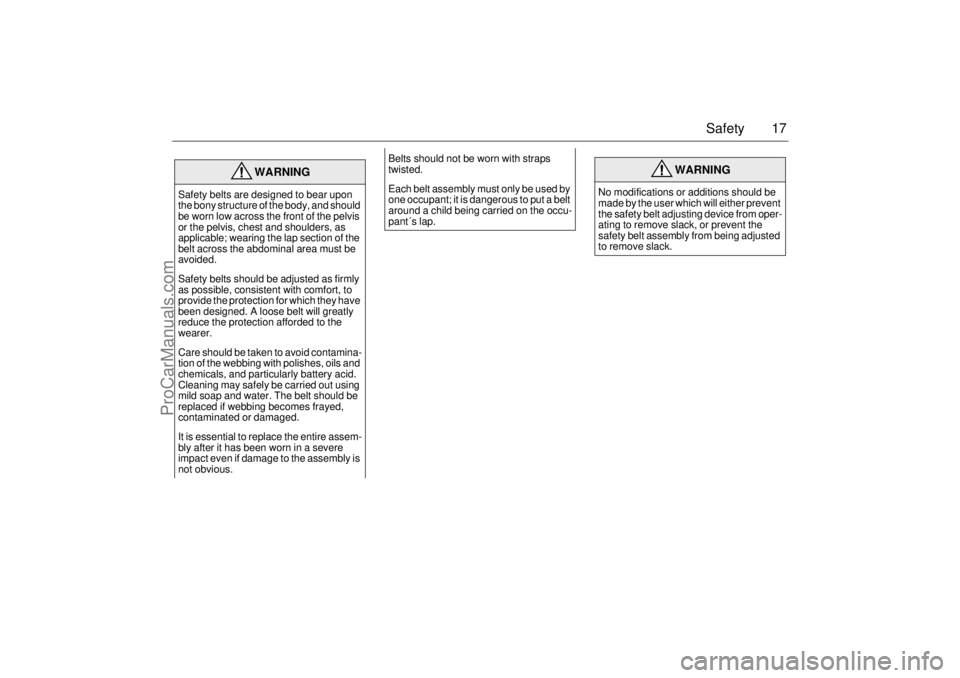
17 Safety
WARNING
Safety belts are designed to bear upon
the bony structure of the body, and should
be worn low across the front of the pelvis
or the pelvis, chest and shoulders, as
applicable; wearing the lap section of the
belt across the abdominal area must be
avoided.
Safety belts should be adjusted as firmly
as possible, consistent with comfort, to
provide the protection for which they have
been designed. A loose belt will greatly
reduce the protection afforded to the
wearer.
Care should be taken to avoid contamina-
tion of the webbing with polishes, oils and
chemicals, and particularly battery acid.
Cleaning may safely be carried out using
mild soap and water. The belt should be
replaced if webbing becomes frayed,
contaminated or damaged.
It is essential to replace the entire assem-
bly after it has been worn in a severe
impact even if damage to the assembly is
not obvious.
Belts should not be worn with straps
twisted.
Each belt assembly must only be used by
one occupant; it is dangerous to put a belt
around a child being carried on the occu-
pant´s lap.
WARNING
No modifications or additions should be
made by the user which will either prevent
the safety belt adjusting device from oper-
ating to remove slack, or prevent the
safety belt assembly from being adjusted
to remove slack.
ProCarManuals.com
Page 18 of 236
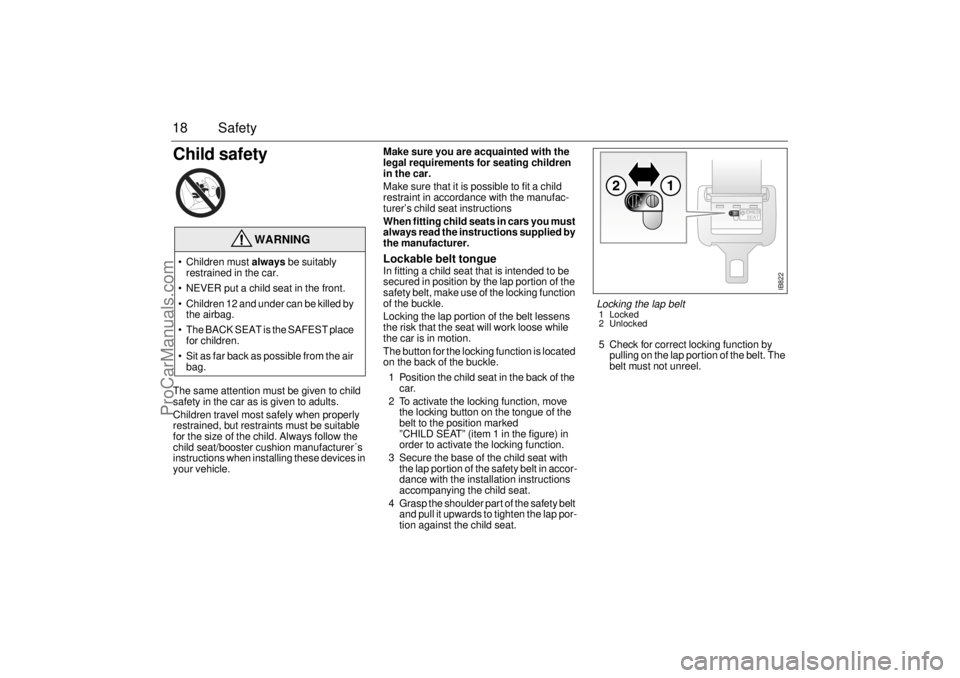
18 SafetyChild safetyThe same attention must be given to child
safety in the car as is given to adults.
Children travel most safely when properly
restrained, but restraints must be suitable
for the size of the child. Always follow the
child seat/booster cushion manufacturer´s
instructions when installing these devices in
your vehicle. Make sure you are acquainted with the
legal requirements for seating children
in the car.
Make sure that it is possible to fit a child
restraint in accordance with the manufac-
turer’s child seat instructions
When fitting child seats in cars you must
always read the instructions supplied by
the manufacturer.
Lockable belt tongue In fitting a child seat that is intended to be
secured in position by the lap portion of the
safety belt, make use of the locking function
of the buckle.
Locking the lap portion of the belt lessens
the risk that the seat will work loose while
the car is in motion.
The button for the locking function is located
on the back of the buckle.
1 Position the child seat in the back of the
car.
2 To activate the locking function, move
the locking button on the tongue of the
belt to the position marked
”CHILD SEAT” (item 1 in the figure) in
order to activate the locking function.
3 Secure the base of the child seat with
the lap portion of the safety belt in accor-
dance with the installation instructions
accompanying the child seat.
4 Grasp the shoulder part of the safety belt
and pull it upwards to tighten the lap por-
tion against the child seat. 5 Check for correct locking function by
pulling on the lap portion of the belt. The
belt must not unreel.
WARNING
Children must always be suitably
restrained in the car.
NEVER put a child seat in the front.
Children 12 and under can be killed by
the airbag.
The BACK SEAT is the SAFEST place
for children.
Sit as far back as possible from the air
bag.
IB822
Locking the lap belt 1 Locked
2 Unlocked
ProCarManuals.com
Page 19 of 236
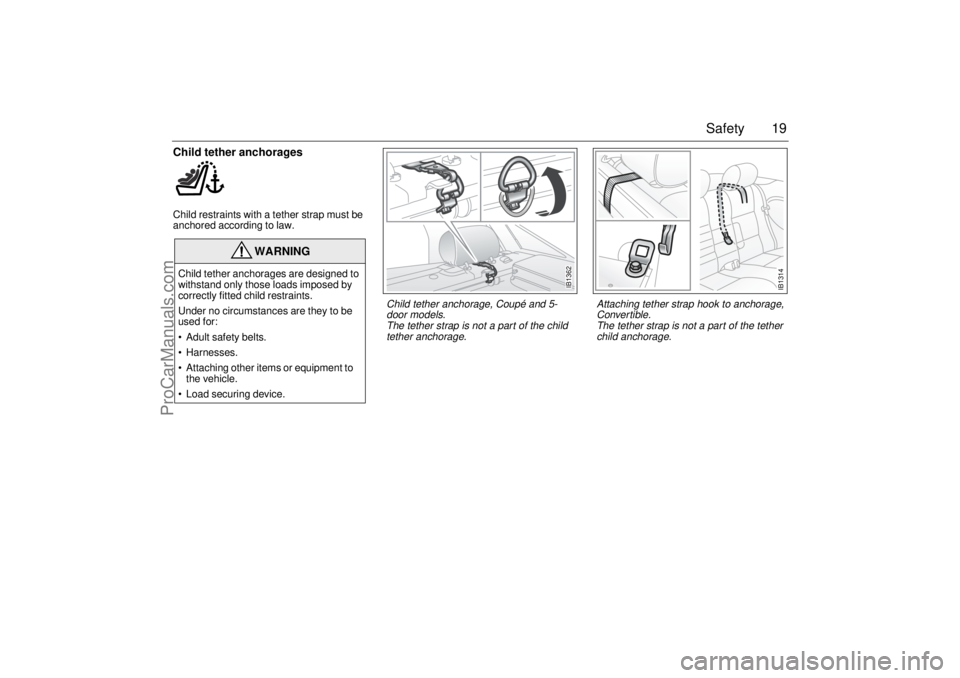
19 Safety
Child tether anchoragesChild restraints with a tether strap must be
anchored according to law.
WARNING
Child tether anchorages are designed to
withstand only those loads imposed by
correctly fitted child restraints.
Under no circumstances are they to be
used for:
Adult safety belts.
Harnesses.
Attaching other items or equipment to
the vehicle.
Load securing device.
IB1314
Attaching tether strap hook to anchorage,
Conver tible.
The tether strap is not a part of the tether
child anchorage.
IB1362
Child tether anchorage, Coupé and 5-
door models.
The tether strap is not a part of the child
tether anchorage.
ProCarManuals.com
Page 20 of 236
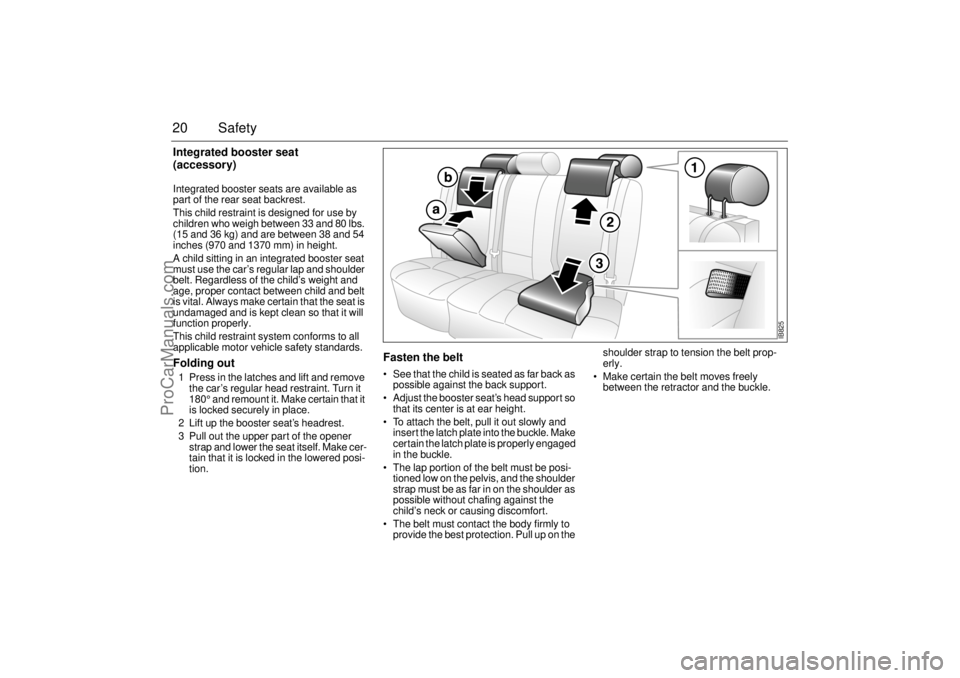
20 SafetyIntegrated booster seat
(accessory)Integrated booster seats are available as
part of the rear seat backrest.
This child restraint is designed for use by
children who weigh between 33 and 80 lbs.
(15 and 36 kg) and are between 38 and 54
inches (970 and 1370 mm) in height.
A child sitting in an integrated booster seat
must use the car’s regular lap and shoulder
belt. Regardless of the child’s weight and
age, proper contact between child and belt
is vital. Always make certain that the seat is
undamaged and is kept clean so that it will
function properly.
This child restraint system conforms to all
applicable motor vehicle safety standards. Folding out 1 Press in the latches and lift and remove
the car’s regular head restraint. Turn it
180° and remount it. Make certain that it
is locked securely in place.
2 Lift up the booster seat’s headrest.
3 Pull out the upper part of the opener
strap and lower the seat itself. Make cer-
tain that it is locked in the lowered posi-
tion.
Fasten the belt See that the child is seated as far back as
possible against the back support.
Adjust the booster seat’s head support so
that its center is at ear height.
To attach the belt, pull it out slowly and
insert the latch plate into the buckle. Make
certain the latch plate is properly engaged
in the buckle.
The lap portion of the belt must be posi-
tioned low on the pelvis, and the shoulder
strap must be as far in on the shoulder as
possible without chafing against the
child’s neck or causing discomfort.
The belt must contact the body firmly to
provide the best protection. Pull up on the shoulder strap to tension the belt prop-
erly.
Make certain the belt moves freely
between the retractor and the buckle.
IB825
ProCarManuals.com